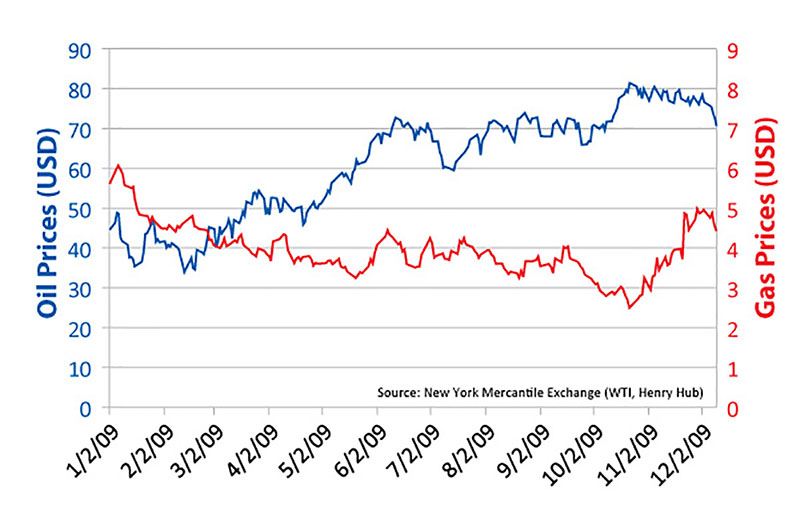The year of living dangerously: Grim days, challenging conditions, exciting discoveries. A look back at the top global developments of 2009.

Oil and Gas Prices - 2009
The industry was walking on eggshells when 2009 opened. Oil was at $44.60 a barrel and natural gas tabbed at $5.62 per mm BTU, with both commodities continuing the downward roll that began with a landslide late the summer before.
Eggshells? The fear was that we might soon be walking on broken glass.
February was the bleakest month for oil, which hit the ’09 low of $33.87. Gas waited until late summer to hit bottom, touching $2.50 before limping to about double by year’s end.
“Abrupt changes in markets, prices and demand created urgent challenges across all the energy industries, while technology and new policies raised fresh uncertainties for 2009 and far beyond,” said Ken White, IHS senior editor – International Oil Letter, who analyzied the year’s discoveries for the Explorer.
“Project financing had all but disappeared,” he said, “and energy companies were forced to cut back on projected investment spending.”
Despite the impediments, the industry responded with a remarkable year.
As White said, “With exploration drilling contracting by nearly 20 percent, it is all the more encouraging that the overall success rate in 2009 averaged 37 percent, just one percentage point down on the previous year.”
For 2009 discovery-leader Brazil, it seemed press releases reported a discovery both onshore and offshore almost daily in ’09.
For perspective, companies operating in Brazil must inform the National Petroleum Agency (ANP) of indications of oil, gas or hydrocarbons in any exploratory well within 48 hours. The disclosures are routine, and do not necessarily indicate commercial viability.
However, there were plenty of finds worthy of reporting in Brazil, with 10 discoveries deemed viable by IHS – with the offshore Santos Basin yielding six discoveries and the Espirito Santos Basin three.
The massive pre-salt area runs 800 kilometers along Brazil’s Atlantic coast and has oil deposits beneath a layer of salt resting as much as 3,000 meters beneath the ocean surface and another 3,000 to 5,000 meters below the seabed.
One of the more notable of the remarkable discoveries is the Guara project in the Santos, with estimates up to two billion barrels of oil in place.
Interestingly, White pointed out that “state companies, prolific in the acquisition of assets through 2009, hardly feature when looking at the largest discoveries of the year in terms of reserve size.
“Indeed, only Petrobras and Iran’s National Oil Company made the top flight with the largest discoveries attributed to two international players in the Kurdistan region of Iraq – Heritage Oil with its Miran West 1 and Gulfsands with Shaikan 1.”
White noted the two Kurdish wells combined added recoverable reserves of over 3.4 billion barrels and helped underline the resurgence of the Middle East.
Also of major note, White said “further success in the deepwater off Israel very early in the year proved a scene-opener for the Middle East.”
Noble Energy was thought to have established seven Tcf of gas in place with its Tamar 1 well, and followed this with success at Dalit 1 in the same basin. Exploration drilling offshore Africa in 2009 also produced some modest but nonetheless significant results, White said.
White said that while clarity on reserves is yet to be established, Anadarko’s Venus B-1 oil and gas discovery in the deep water off Sierra Leone and the Hess A1-54/1 gas/condensate discovery in the Sirte Basin offshore Libya are viewed as very encouraging play openers.
“The major implication of Venus B-1 is that it ‘de-risks’ a number of similar prospects that have been identified along the West African coast between the giant Jubilee field in Ghana and Sierra Leone, a distance of roughly 1,100 kilometers,” White said.
“The Hess discovery is a play opener,” he added, “because the offshore Sirte Basin is still unexplored and the quality of the find is such that some in the industry are suggesting reserves of seven Tcf.”
The Gulf of Mexico recorded 10 discoveries, with BP making a “giant” find in the Tiber prospect in the Keathley Canyon with a potential of three billion boe. Tiber is in 4,132 feet of water with a 35,055 foot-TD – believed to be the deepest ocean-depth well ever.
Tiber also produces from the Upper Tertiary, same as Chevron’s Buckskin No. 1 discovery well announced in February. Buckskin, also in Keithley Canyon, is located in about 6,920 feet of water and was drilled to 29,404 feet.
As 2009 is behind us, the new year opens with oil near $70 and gas limping along around $5 and global oil demand projections wobbling in concert with the latest economic surveys.
The specter of a new round of company consolidations was raised by the mid-December ExxonMobil all-stock buyout of XTO, and any company with reserves that used to be viewed as a weed suddenly became a flower.
While overall budgets are still being trimmed, there also have been announcements of more of the budgets to be shifted to the exploration side of the business – including Chevron, ConocoPhillips, Hess and Marathon.
White also noted some encouraging news: financing difficulties have eased such that world-class projects like the US $37 billion Gorgon LNG project in Western Australia are proceeding.
Meanwhile, the industry progresses – on eggshells.